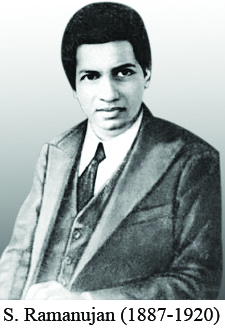 The story of how maths genius Srinivasa Ramanujan (1887-1920) was discovered by the world is one of the most engaging accounts in the history of mathematics. In 1913, Ramanujan wrote a ten-page letter containing 120 theorems to eminent English mathematician G.H. Hardy of Trinity College, Cambridge (UK). Hardy took hours to analyse the authenticity of the letter — to ascertain whether it was written by a “crank or a genius”. After consultations with several math professors he came to the latter conclusion. “They must be true, because if they were not true, no one would have had the imagination to invent them,’’ he remarked.
The story of how maths genius Srinivasa Ramanujan (1887-1920) was discovered by the world is one of the most engaging accounts in the history of mathematics. In 1913, Ramanujan wrote a ten-page letter containing 120 theorems to eminent English mathematician G.H. Hardy of Trinity College, Cambridge (UK). Hardy took hours to analyse the authenticity of the letter — to ascertain whether it was written by a “crank or a genius”. After consultations with several math professors he came to the latter conclusion. “They must be true, because if they were not true, no one would have had the imagination to invent them,’’ he remarked.
Born on December 22, 1887, into a poor Hindu Brahmin family in Erode, Tamil Nadu, Ramanujan was an autodidact who cultivated his love for mathematics in total isolation. His introduction to formal mathematics was at age ten when a friend gave him a trigonometry text by S.L. Loney (published by Cambridge University Press, 1894) which he mastered in a short span of two years, proving some important theorems and identities independently. However the book that changed his life was George Schoobridge Carr’s A Synopsis of Elementary Results in Pure and Applied Mathematics — a compilation of 6,615 theorems. By age 17, he was researching advance number theory, including Bernoulli numbers and the Euler-Mascheroni constant.
In 1903, Ramanujan was awarded a scholarship to study at the Government College, Kumbakonam which was later rescinded when he failed in all subjects except mathematics. Four years later, he enrolled in Pachaiyappa’s College (estb. 1842), Chennai, but could not pass his undergrad degree exam. In 1909, he married Janakiammal and to support his family, took a job as a clerk in the Madras Port Trust (MPT). At the suggestion of MPT manager S.N. Aiyar, he wrote to three Cambridge mathematicians including G.H. Hardy at Trinity College describing his work. Hardy’s approval of his work exalted Ramanujan’s status almost immediately and he was appointed a research scholar of the University of Madras, at twice his clerical salary. Hardy invited Ramanujan to Trinity College and on March 1914, Ramanujan sailed to England just a few months before the First World War broke out in Europe.
Ramanujan’s arrival at Cambridge was the beginning of a successful five-year collaboration with Hardy although they were contrasting personalities. Hardy was rigourous in his analysis, while Ramanujan’s conclusions were “arrived at by a process of mingled argument, intuition, and induction, of which he was entirely unable to give any coherent account”. During the period 1914-1917, Hardy and Ramanujan jointly wrote more than half a dozen research papers with Ramanujan publishing more than 30 papers independently. But the paper that really changed the course of 20th century mathematics was one written by Ramanujan in 1916 in which he investigated the properties of Fourier coefficients of modular forms.
Ramanujan soon began to attract international recognition. He was awarded a BA degree (later upgraded to a Ph D) by Cambridge University in March 1916 for his work on highly composite numbers, and in 1917 he was elected a member of the London Mathematical Society. He was appointed a fellow of the Royal Society in 1918 for his investigations on Elliptic functions and the Theory of Numbers, and subsequently became the first Indian to be elected a fellow of Trinity College, Cambridge. However, the cold climate and scarcity of vegetarian food in wartime England took a toll on his health and he was hospitalized in 1917 with tuberculosis and severe vitamin deficiency. In 1918 his health improved and he returned to India the following year. However he passed away on April 20, 1920.
During his final days, he wrote one last letter to Hardy in January 1920 outlining his discovery of mock theta functions, considered to be among his most significant contributions. Now almost 100 years later, mathematician Ken Ono of Emory University and his team of researchers have proved he was right.
As India and the world celebrate the 125th birth anniversary of Ramanujan, his life story and work will continue to inspire generations of math lovers.























